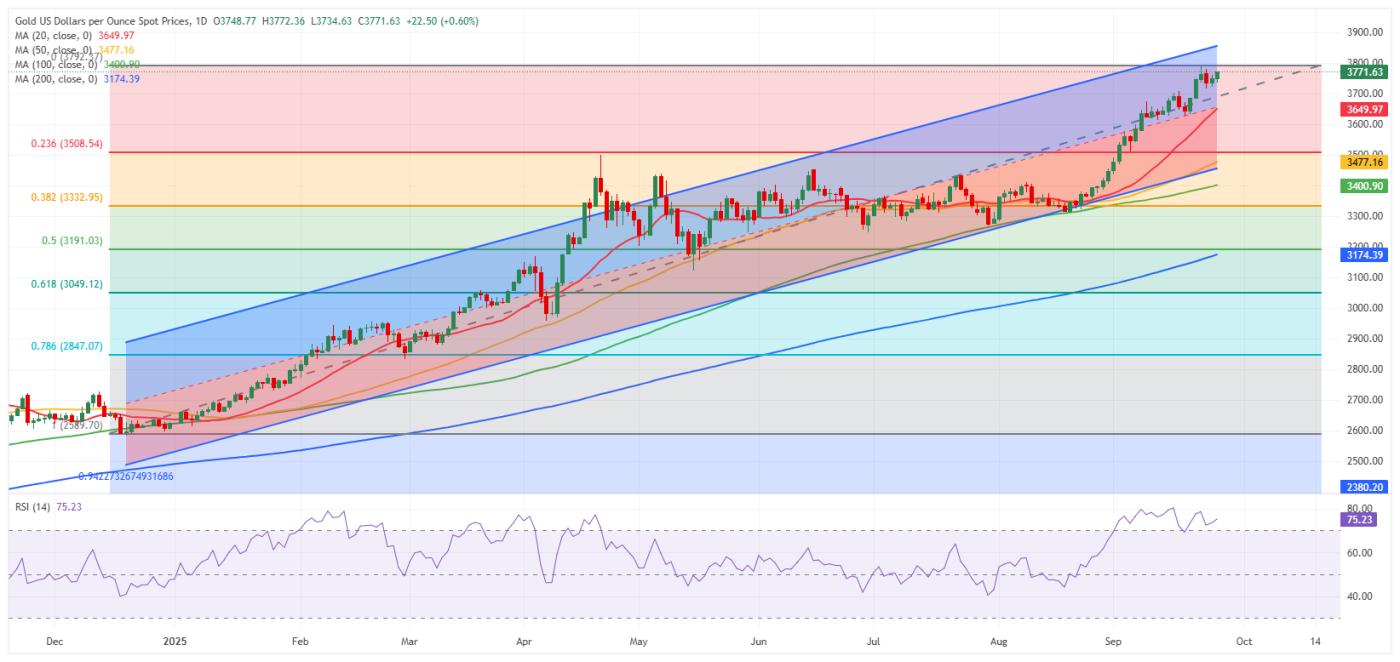Gold (XAU/USD) hit a fresh record high near $3,790 before correcting lower.
Investors will be XEM closely at key data from the US to decide whether the XAU/USD rally can continue in the short term.
Gold enters accumulation phase below record peak
Escalating geopolitical tensions helped boost gold prices at the start of the week. News that NATO forces intercepted three Russian MiG-31 jets after they entered Estonian airspace unnerved investors and boosted demand for safe havens.
After rising more than 1.5% on Monday, XAU/USD continued to push higher early Tuesday and hit a new record high of $3,791. XAU/EUR and XAU/GBP also hit record highs after disappointing Purchasing Managers’ Index (PMI) data showed that Gold attracted Capital outflows from the Euro and the British Pound.
In the second half of the day, renewed strength in the US Dollar (USD) due to Federal Reserve (Fed) Chairman Jerome Powell's cautious tone on policy easing and US S&P Global PMI data for September showing private sector business activity continued to expand at a healthy pace, sent XAU/USD back down.
Speaking on the economic outlook on Tuesday, Powell stressed that they would ensure that a one-time price increase does not become a persistent inflation problem. He also noted that they would XEM at the labor market, growth and inflation data to assess whether policy is in the right place at the next meeting.
The USD continued to outperform its rivals on Wednesday after data showed New Home Sales rose 20.5% in August, easing concerns about housing market conditions. On Thursday, the USD continued to gain momentum after the US Bureau of Economic Analysis (BEA) announced that it revised the annualized Gross Domestic Product (GDP) growth for the second quarter to 3.8% from the previous estimate of 3.3%.
Furthermore, Durable Goods Orders rose 2.9% in August, far exceeding market expectations for a 0.5% decline, and Weekly Jobless Claims fell to 218,000 from 232,000 the previous week. Broad USD strength kept XAU/USD in a consolidation phase around $3,750 in the second half of the week.
Data later in the week showed that U.S. annual inflation, as measured by the change in the Personal Consumption Expenditures (PCE) Price Index, rose to 2.7% in August from 2.6% in July. The core PCE Price Index, which excludes volatile food and energy prices, rose 2.9% in the same period, matching July's increase and analysts' estimates. Those figures were largely ignored by the market.
However, a bullish open on Wall Street took some of the USD's breath away and allowed Gold to edge higher during the US session on Friday.
Gold investors will XEM to US data to gauge Fed policy outlook
The US economic calendar will provide some important data that could influence Fed policy pricing and the near-term direction of Gold's value.
The CME Group FedWatch tool shows that the market is widely expecting the Fed to choose to cut interest rates by another 25 basis points (bps) in October. The probability of another rate cut in December remains at around 60%, down from nearly 80% before the US data mentioned above. Powell and several other policymakers have acknowledged the rising risks to the labor market and explained that a rate cut in September was appropriate to offset these risks.
On Tuesday, the US Bureau of Labor Statistics (BLS) will release JOLTS Job Openings data for August. While this is considered a lagging indicator, a significant decline, with a figure below 7 million, or a significant positive surprise above 7.5 million could trigger a clear reaction.
ADP Employment Change and ISM Manufacturing PMI data for September will be closely watched midweek. If private sector employment rises above 70,000 and the core Manufacturing PMI rebounds into expansionary territory above 50, the USD could maintain its strength and drive XAU/USD lower.
Nonfarm payrolls ( NFP ) could add to market volatility on Friday. After disappointing numbers over the past few months, another disappointing NFP report could cement the Fed’s December rate cut and weigh heavily on the USD and US Treasury yields.
In this scenario, Gold could gain upside momentum heading into the weekend. Conversely, the USD could continue to rally and weigh heavily on XAU/USD if NFP rises above 70,000 and concerns about labor market conditions ease.
 US economic calendar. Source: FXStreet
US economic calendar. Source: FXStreetGold technical analysis
Despite the recent correction, Gold remains technically overbought with the Relative Strength Index (RSI) on the daily chart holding firmly above 70. However, XAU/USD remains within the upper half of its nine-month-long bullish regression channel and is trading well above its 20-day Simple Moving Medium (SMA), suggesting that the uptrend remains intact with a potential technical correction.
 XAU/USD price analysis. Source: TradingView
XAU/USD price analysis. Source: TradingViewOn the downside, $3,670 (midpoint of the ascending channel, 20-day SMA) is the first support, followed by $3,500-$3,480 (static level, round number, 50-day SMA). Looking north, the first resistance can be found at $3,790-$3,800 (record high, round number), $3,860 (upper limit of the ascending channel) and $3,900 (round number).







